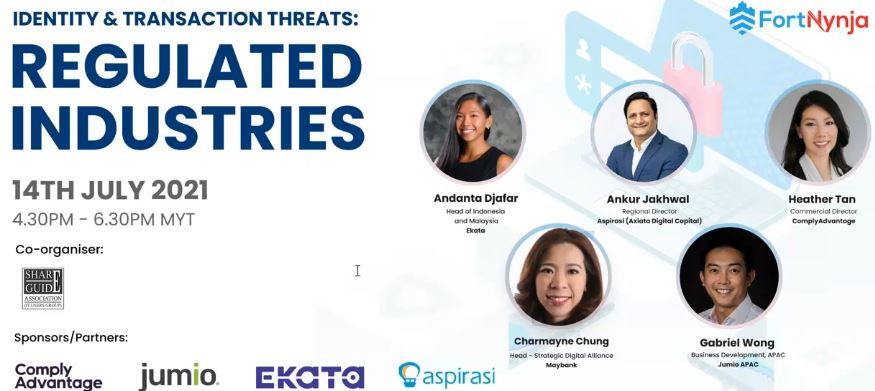Estimated reading time: 5 minutes
E-commerce and online sales have boomed during this new normal of social distancing. This sets the stage for an increase in identity thefts and fraudulent transactions.
So, it was timely that ShareGuide collaborated with FortNynja to raise awareness about this rising phenomenon. A panel discussion moderated by Jenna Huey and comprising of Ekata, Maybank, Aspirasi (an Axiata company), Jumio and Comply Advantage, did an admirable job of this.
Maybank’s Charmayne observed identity theft and fraud transactions as being an eventuality. Thefts and fraud, in some way, shape, or form, are happening everyday to many people. “It’s not just in the banking sector. If you look at different industries like gaming and entertainment, (companies) get hacked all the time.
“This is basically the reality of whats happening out there, today. The moment we are in the digital world, it’s an eventuality and merely a matter of when we would be hacked. So, its important to take precautions to anticipate what’s going to come our way,” Charmayne said.
Table of contents
Maintaining balance
Jumio’s Gabriel agreed with Charmayne’s observation and took a step back from the scenario to highlight false acceptance rates; acceptance of an applicant to be a customer when they actually should be rejected.
In essence, a balance needs to be maintained between FAR and the time it takes to onboard customers. Both are metrics which have to be kept as low as possible.
Gabriel pointed out that most regulators have a (FAR) threshold, and it could range anywhere from 2-percent to 3- percent. “So, they do accept there is going to be fraud happening, and to protect the integrity of the financial system, to promote digital inclusion, there has to be a threshold.”
Basically, this threshold has to balance with between the time it takes to open a new account with the time it takes to have all the verifications and checks in place. But, there are other metrics to consider as well.
Comply Advantage’s Heather described one of her organisation’s wins as helping a bank client reduce their overall customer onboarding time by 75-percent, without the client needing to add bodies to their compliance team.
Challenges
Accuracy of a customer’s viability
Ekata’s Adanta also posed reasons why it is especially important now to protect against identity theft and fraud transactions.
A recent Google, Temasek and Bain study, shows that around 40 million new customers have joined and started transacting digitally, just last year due to COVID-19. This is a massive number of new users suddenly going onto the Internet to buy, sell, and transact financially.
Andanta said, “I think a lot of companies realise that it’s an opportunity to acquire new customers onto their platform. But now they’ve also realised that they’re susceptible to fraud, cybersecurity, e-KYC (electronic know-your-customer) processes, and etc.
And so, companies are struggling to go digital. This has impacted their customer acquisition or onboarding process.
She also finetuned the customer onboarding process into a more apt metric that better reflects the customer’s experience with banks – customer friction.
“Banks can’t reject every customer that looks suspicious… but how suspicious can a customer be, before they are?”
“A customer that is falsely declined has 30 to 40 percent probability of not returning to the platform (that rejected them),” she said.
This makes false rejects risky as well due to potential loss of business.
But, it is worth noting that 70-percent of customers that experience fraud on a platform, will also not return to that platform.
Not enough data?
Banks have to carefully decide what customers to onboard or decline, during the eKYC process. But what data should they look at to be able to make that decision?
Aspirasi’s Ankur, knew that with the unbanked and underserved audience Aspirasi is serving, they could not look at the traditional data that banks usually rely on. He said, “I cannot have the traditional approach with these customers because there is no history, right?
“As a financial institution, I would like to look at the balance sheet, or at least a bank statement. But the market are SMEs who deal in cash because they do not have any bank facilities available.”
Ankur shared when Aspirasi launched in Indonesia, they were loaning sums like USD45 for a period of seven days.
He explained, “We looked at the whole chain of distribution – Who is the borrower associated with? Where are her customers? – We rationalised that she will never default on her loan from the party which is earning her bread and butter ie. the distributor who sells top-up/prepaid coupons.”
Needing a new lens to digitally identify customers
Andanta opined, “So being unbanked and underserved, does not mean they are not viable customers. I think we need to change the way we approach authentication (of customers) especially within these regions. This way, we can have enough data and understanding to identify and approve these good potential customers.
“That cannot be done conventionally, ” she said. She also added email address, physical address, phone numbers and behavioural patterns can be good indicators to gain more insights.
Jenna the moderator pointed out how daunting it is for organisations to handle an (unprecedented) amount of customers onboarding and opening accounts. A delicate balance has to be maintained on all the fronts mentioned in this article.
Failure to maintain this, carries the risk of penalties from regulators, which nobody wants.







